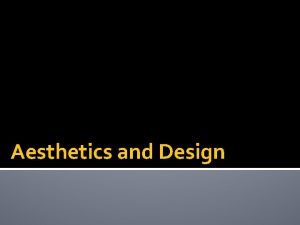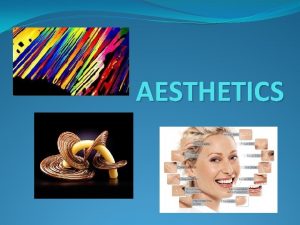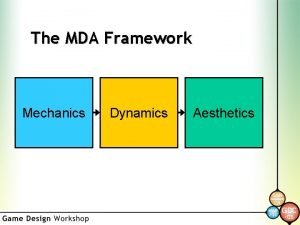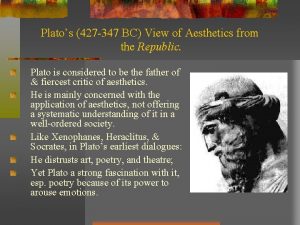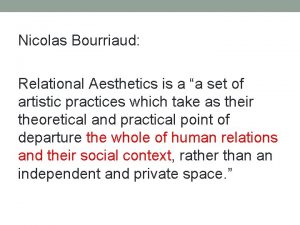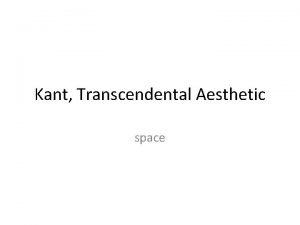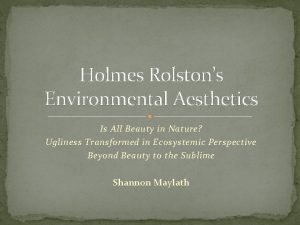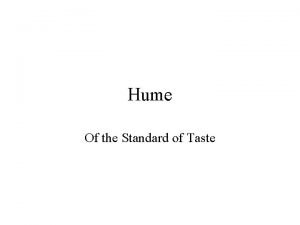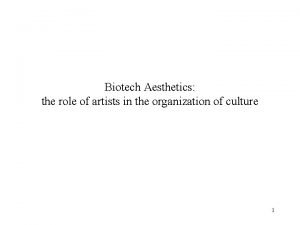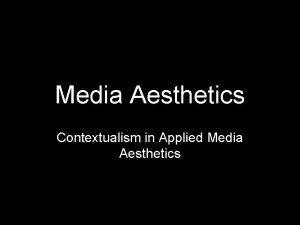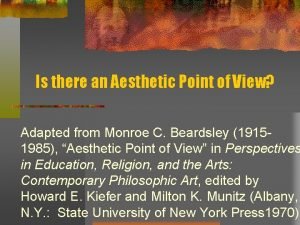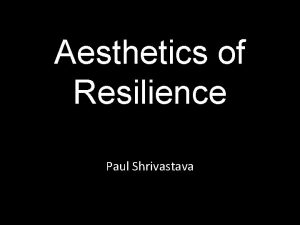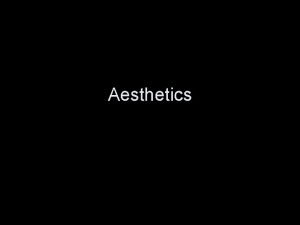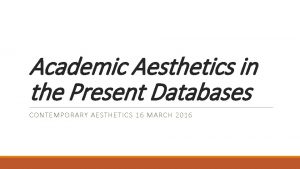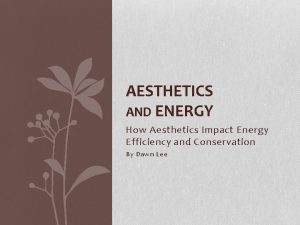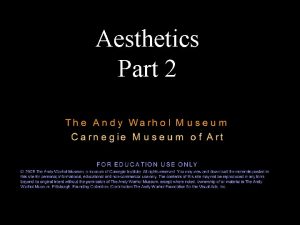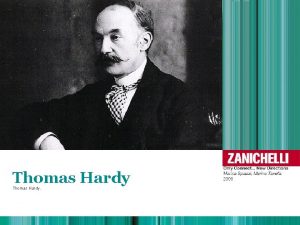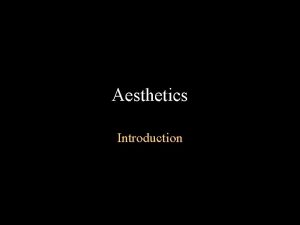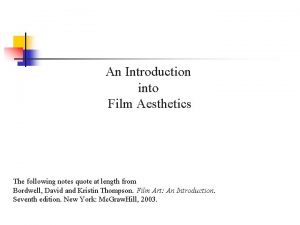An Introduction to the Aesthetics of St Thomas




















- Slides: 20

+ An Introduction to the Aesthetics of St. Thomas Aquinas: 1225 - 7 March 1274 (Sicily). www. prshockley. org

+ Consider… “Good is the object of desire… Beauty, on the other hand, is the object of cognitive power, for we call beautiful things which give pleasure when they are seen; thus beauty rests on proper proportion, because the senses delight in things with proper proportion as being similar to themselves; for the sense and all cognitive power is a kind of reason, and because cognition takes place by means of assimilation, and assimilation pertains to form, beauty properly belongs to the concepts of formal cause. ” Summa Theologiae, I q. 5 a 4 ad. 1

+ What is beauty? n. Aquinas defined beauty as that which gives pleasure when seen [ST 1 -11, 27. 1). n. But what does the word “seen” mean?

+ “Seen” is the “activity of contemplation” “Beauty is essentially the object of intelligence, for what knows in the full meaning of the word is the mind, which alone is open to the infinity of being. The natural sight of beauty is the intelligible world; then it descends. But if falls in a away within the grasp of the senses, since the senses in the case of man serve the mind and can themselves rejoice in knowing: ‘the beautiful relates only to sight and hearing of all senses, because these two are maxime cognoscitivi [Maritain, 23]. ~ Jacques Maritain, Art and Scholasticism, trans. J. F. Scanlan (New York: Charles Scribner’s Sons, 1930).

+ What is beauty? n “…beauty relates to the cognitive faculty; for beautiful things are those which please when seen. Hence, beauty consists in due proportion; for the senses delight in duly proportioned, as in what is after their own kind-because even sense is a sort of reason, just as is every cognitive faculty. Now, since knowledge is by assimilation, and similarity relates to form, beauty properly belongs to the nature of a formal cause” [Q. 5, Art. 4].

+ Beauty is an activity of the mind. How?

+ The form of the matter exist in the mind of the knower. Step 1: Gaze at this blue rose. Allow the rose to be received by your physical senses. Step 2: The same form, which is immaterial, of the blue rose, begins to exist in your mind. At this point you have knowledge for the form of the object, without its matter, exists in your mind. Step 3: Contemplate the form. Step 4: Your reaction is “The rose is _______. ”

+ 1. Your physical senses do not recognize the blue rose to be beautiful. 2. Instead, your mind is responsible for recognizing the beauty of the blue rose. 3. Knowledge has two aspects: (1) passive part receives the data from outside of your mind (extra-mental reality) whereas the (2) active part of your mind abstracts the forms new existence in your mind. The apprehension of beauty is the result of your mind.

+ Sight and hearing are the most important physical senses for cognitive beauty since it is through those senses that one perceives and extracts the form from the object. Sight Hearing

+ Four-fold Criteria or Standards of Beauty: Actuality Proportion Radiance Integrity ST, 1. 39. 8 c

+ This list is centered on the Trinitarian relationship of God who is Pure Actuality with No Potentiality: The Son has Integrity insofar as he “has in Himself truly and perfectly the nature of the Father” The Son has proportion “inasmuch as He is the express Image of the Father. ” Radiance (brightness or clarity) is found in the Son, as the Word, “which is the light and splendor of the Intellect. ”

+ n A Closer Look: Actuality is the Ground of Beauty: Actuality is the basis and ultimate source of reality. As a result, actuality is the ground of beauty: n Beauty is grounded in the actual existence of the object. n Everything that has existence will also have some degree of beauty (even if it is very little). n If the object does not exist, then it is not beautiful; it is nothing. n Form and action are aspects of actuality.

+ Form: “As each thing has its own form, so it has its own distinctive beauty. ” n Form is what separates the existence of different things. n A dog exists as a dog; you exists a human. I exist as an X-Man. n Everything is what it is because of its own form. n An object has more goodness and beauty when it achieves a higher level of perfection in its form. n A plum tree is beautiful to the degree in which it perfectly attains to the form of a plum tree.

+ Action: “Action completes the actuality of existence and form”: n While action is not a characteristic of a beautiful object, it is a necessary in order for something to be beautiful. n A body builder who is in the act of weightlifting is most complete as opposed to one laying around on the couch eating chips and candy while sipping on cokes.

+ Proportion: The Fact of Harmony: n “Proportion is twofold: In one sense it means a certain relation of one quantity to another, according as double, treble and equal are species of proportion. In another sense every relation to one thing to another is called proportion. And in this sense there can be a proportion of the creature to God, inasmuch as it is related to Him as the effect of its cause, and as potentiality to its act; and in this way the created intellect can be proportioned to know God (ST I. 12. 1). ” n Proportion involves both quantity (mathematical) and quality (agreement; analogy; mutual reference; e. g. , matter to form; cause to effect; Creator to created).

+ Radiance: Luminosity which emanates a beautiful object: “Radiance belongs to being considered precisely as beautiful: it is, in being, that which catches the eye, or the ear, or the mind, and makes us want to perceive it again” [Etienne Gilson, The Arts of the Beautiful (Dalkey Archive Press, 2000), 35]. Because all that is beautiful is connected to God, the Cause of all beauty, radiance will find expression. “Beauty consists in a certain lustre and proportion” ~ Aquinas in Summa Theol. , II-ae q. 180 a. 2 ad. 3. Consider this example …

call a man beautiful + n “We because of its fitting proportion of his members in their number and arrangement, and because of his having a bright and glowing colour. Consequently, it should be assumed in other cases too that the name of beauty is given to all that which has the clarity proper to its kind, whether spiritual or physical, and which is constructed in proper proportion. ” n De div. c. IV lect 5 (Mandonnet, 362 -363).

+ Integrity (wholeness): Two aspects: n 1: Integrity involves its existence (esse), its being-lacks nothing essential or substantive to its primal nature. n 2. Integrity involves its action; it lacks nothing in its ability necessary for completion.

+ Quote on Conditions of Beauty: n “Beauty demands the fulfillment of three conditions: the first is integrity, or perfection of the thing, for what is defective is, is consequence, ugly; the second is proper proportion, or harmony; and the third is claritythus things which have glowing colors are said to be beautiful. ” ~ Summa Theol. , I q. 39 a. 8.

+ Bibliography: Michael Spicher, “Medieval Theories of Aesthetics” in the Internet Encyclopedia of Philosophy (11 December 2010); Wladyslaw Tatarkiewics, History of Aesthetics, Volume 2 (New York: Continuum, 1995, 2000).
 Introduction to aesthetics
Introduction to aesthetics Forensic anthropologist vs forensic pathologist
Forensic anthropologist vs forensic pathologist Gestalt approach
Gestalt approach Racquel aesthetics
Racquel aesthetics Aesthetics elements
Aesthetics elements The concept of aesthetics
The concept of aesthetics Mda aesthetics
Mda aesthetics The aesthetics studio
The aesthetics studio Plato aesthetics
Plato aesthetics Bourriaud relational aesthetics
Bourriaud relational aesthetics Transcendental aesthetic
Transcendental aesthetic Beast and beauty aesthetics
Beast and beauty aesthetics Environmental aesthetics
Environmental aesthetics Photography definition in art
Photography definition in art Hegel aesthetics lectures on fine art
Hegel aesthetics lectures on fine art David hume aesthetics
David hume aesthetics Biotechnology aesthetics
Biotechnology aesthetics Applied media aesthetics
Applied media aesthetics Mechanics dynamics aesthetics examples
Mechanics dynamics aesthetics examples Aesthetic point of view
Aesthetic point of view Aesthetics developers
Aesthetics developers




